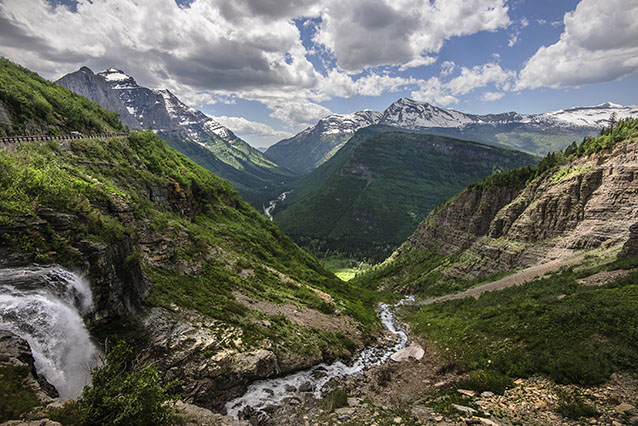Going-to-the-Sun Road winds its way east to west through the heart of Glacier National Park, allowing visitors driving through the park to experience the mountains, hanging valleys, rock walls, and glaciers that make up the northern Rocky Mountains. Almost 50 miles in length, the road crosses several distinct zones of vegetation, from lake-filled valleys to an alpine pass crossing the Continental Divide.
The Going-to-the-Sun Road Historic District is significant to the nation's transportation history because of its unprecedented engineering and its place as a link in the Park-to-Park Highway, first advocated by Stephen Mather in 1915.

NPS / Tim Rains
It is both the only link between the east and west sides of Glacier National Park and the only extensive automobile route in the park. The road defines Glacier’s basic circulation pattern and receives heavy amounts of traffic during the summer months. Because of heavy snowfall, the road is closed during the winter, opening for the season only after a significant snow removal effort.
The historic district begins 30 feet east of the T-junction on the west side of the park (at the southern edge of Lake McDonald) and continues to the eastern park boundary. The district encompasses approximately 355 acres directly surrounding the road. Views from the road are integral to its function of making park scenery available to visitors, and thus are also integral to its character.

NPS / K. Armagost
Construction of Going-to-the-Sun Road, by any standard, was a significant undertaking. The road’s basic infrastructure was developed between 1921 and 1932; at the end of that time, its entire length was officially open to park visitors. However, no portion of the road was considered complete in 1932. Reconstruction and improvement of the roadbed, bridges, drainage system, and rockwork continued until 1955, when the last section was paved in asphalt.
Between 1956 and 1982, work on the road was limited in scope, focused mainly on minimal maintenance and damage repair due to limited funding. Since 2007, approximately $80 million has been spent rehabilitating the road, which has included drainage improvements, slope stabilization, retaining and guard wall repairs, and roadbed resurfacing.

NPS / K. Armagost
Today, the road is notable for the fine stonework of many of its bridges, retaining walls, and smaller stone features; for its tunnels; for its route carved into the side of the Garden Wall; for the imagination of its designers and the labors of its builders; and for the marvelous views it offers as it climbs and then descends the Continental Divide.
The road is nationally significant for its design and monumental engineering accomplishments. The road's resources – the original roadbed, bridges, tunnels, culverts, retaining walls, and guard walls – were built in the “NPS Rustic” style. Individually, these structures are often significant examples of period engineering and design philosophy; collectively, they comprise a vital, integral component of the road’s unique character. Most of these structures were designed to harmonize with the roadway setting by using native materials and by blending with landforms as much as possible.
The importance of the Going-to-the-Sun Road has also been recognized in its designation as a National Historical Civil Engineering Landmark and a National Historic Landmark (NHL). Even today, visitors to the park marvel at how such a road could have been built and how well it blends into its rugged surroundings.
Quick Facts
- Cultural Landscape Type: Designed
- National Register Significance Level: National
- National Register Significance Criteria: A, C
- National Historic Landmark
- Period of Significance: 1921-1952
Landscape Links
Last updated: December 30, 2019
